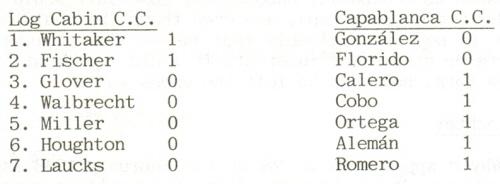Chess Notes
Edward Winter
When contacting us by e-mail, correspondents are asked to include their name and full postal address and, when providing information, to quote exact book and magazine sources. The word ‘chess’ needs to appear in the subject-line or in the message itself.
| First column | << previous | Archives [84] | next >> | Current column |
7133. Chess and Hollywood
As a complement to Chess and Television we have prepared a new feature article, Chess and Hollywood.
The cast includes Humphrey Bogart, Charlie Chaplin, Mae Clarke, Lee J. Cobb, Linda Darnell, James Dean, Olivia de Havilland, Alain Delon, Marlene Dietrich, Marie Dressler, José Ferrer, Errol Flynn, Clark Gable, Viveca Lindfors, Myrna Loy, Ray Milland, Carmen Miranda, Basil Rathbone, James Stewart, Franchot Tone, Spencer Tracy, Lana Turner and Rudolph Valentino.
7134. Capablanca explains his defeat by
Alekhine
John Blackstone (Las Vegas, NV, USA) has forwarded this interview with Capablanca on page C3 of the Brooklyn Daily Eagle, 12 February 1928:
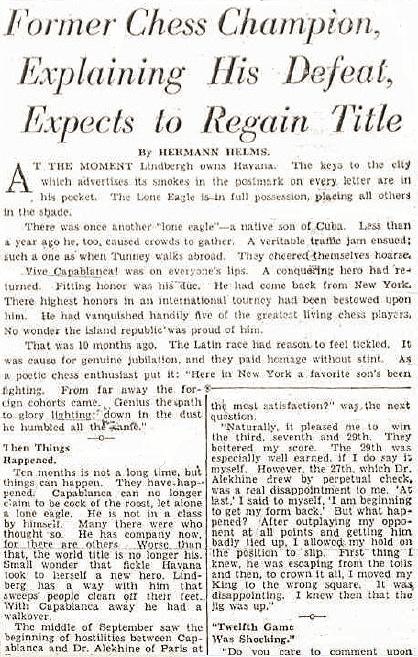
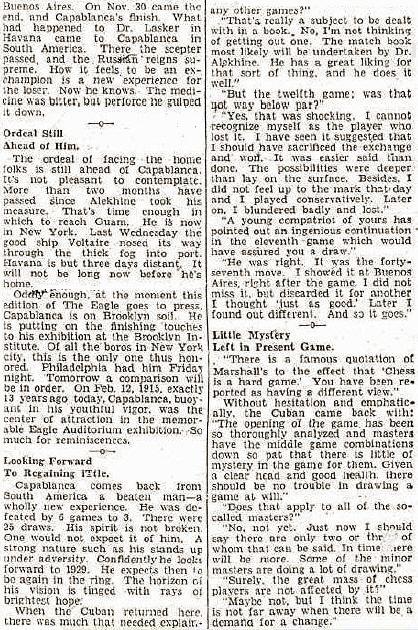
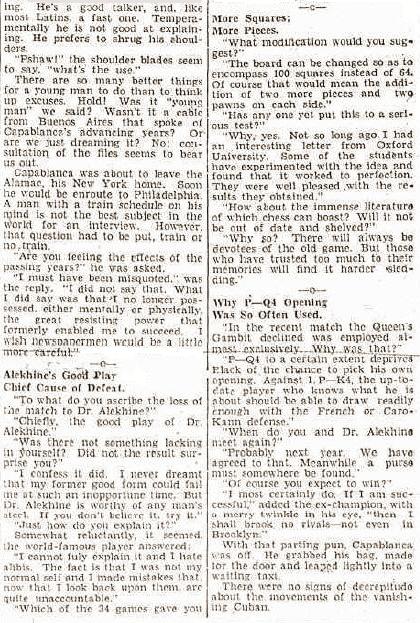
A few gleanings:
- Asked whether his match loss to Alekhine surprised him, Capablanca said:
‘I confess it did. I never dreamt that my former good form could fail me at such an inopportune time. But Dr Alekhine is worthy of any man’s steel. If you don’t believe it, try it.’
‘I cannot fully explain it and I hate alibis. The fact is that I was not my normal self and I made mistakes that now that I look back upon them are quite unaccountable.’
- After throwing away a win in game 27:
‘I knew then that the jig was up.’
- The 12th match-game:
‘Yes, that was shocking. I cannot recognize myself as the player who lost it.’
- On the future of chess:
‘The opening of the game has been so thoroughly analyzed and masters have the middle-game combinations down so pat that there is little of mystery in the game for them. Given a clear head and good health, there should be no trouble in drawing a game at will.’
7135. Quiz questions (C.N. 7132)
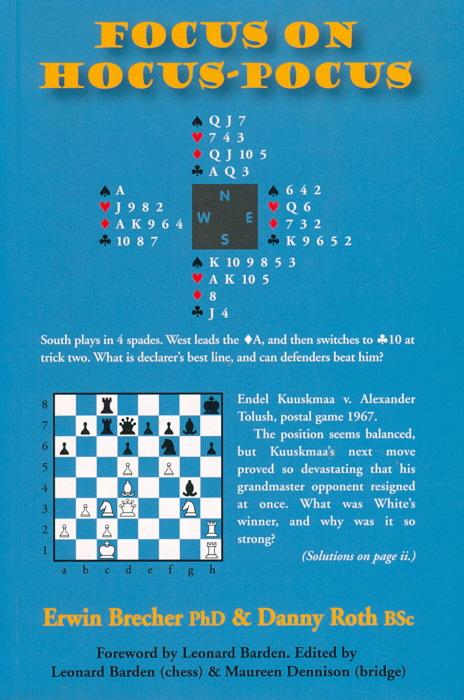
From page ii:

Focus on Hocus-Pocus by E. Brecher and D. Roth was published by Panacea Press Ltd., London in 2004.
7136.
Emma
Keesing
Alain Biénabe (Bordeaux, France) enquires about photographs of Reuben Fine’s first wife, Emma Keesing (1916-60).
We recall the following on page 3 of CHESS, 14 September 1937:
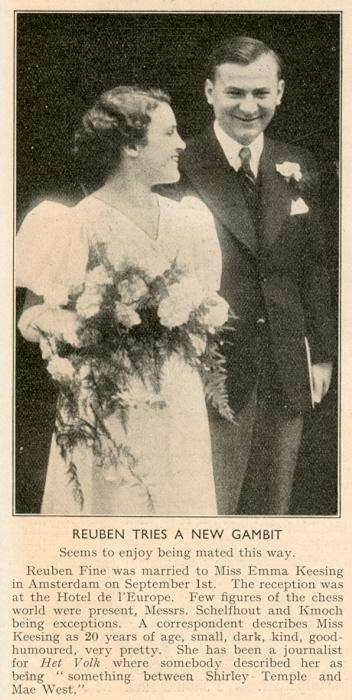
She was aged 21 at the time of their marriage.
The same magazine (14 December 1938 issue, page 142) gave this picture in its coverage of AVRO, 1938:
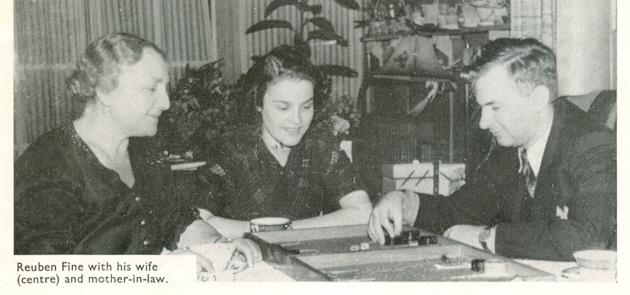
7137. Botvinnik’s match record
Two contributions from readers which originally appeared in 1983 (C.N.s 526 and 560) are reproduced below:
John C. Rather (Kensington, MD, USA) writes:
‘Consider Botvinnik’s indifferent performance as a match player. Despite his long, albeit intermittent, tenure as world champion, he never won a match when defending his title and his overall record of +2 –3 =2 in matches and +36 –39 =82 in points is not impressive.
If one believed in the conspiratorial theory of chess history, the drawn matches with Bronstein and Smyslov and what seemed like the Alphonse-and-Gastoning that followed might be thought to be part of a plot to aggrandize Soviet chess. However, a closer look at Botvinnik’s cumulative performance in the seven matches suggests a more plausible explanation. In games 1-8 he scored +16 –13 =27; in games 8-16 the tally was +15 –11 =30; but after game 16 he could do no better than +5 –15 =25. Surely this raises a question about his physical and/or psychological stamina.
He did come from behind in his 1933 match with Flohr (+2 –2 =8 ), but the closing collapse occurred against Levenfish in 1937 when he scored only +1 –3 at the end, to allow the +5 –5 =3 result. The date of the latter match indicates that his problems in the championship matches may not be attributed to his age alone.’
From William Hartston (Cambridge, England):
‘I had a conversation with Spassky last year which I think throws some light on C.N. 526 (Botvinnik’s match record). I had always supposed that Botvinnik took his first matches rather lightly, in the knowledge that he had the right to a return match if he lost. Spassky’s explanation was more convincing, bearing in mind what we know about Botvinnik’s meticulous approach. He claimed that Botvinnik had already started his preparations for the return match while the first match was in progress. Indeed, one might even accuse him of using the first match as part of those preparations. The exhausting process of winning through the qualifying tournaments, then beating Botvinnik left Smyslov and Tal too exhausted to put up a fight in the “serious” match which followed. With that gloss on chess history, we should perhaps be less impressed with the achievements of Bronstein and Smyslov in 1951 and 1954 in “only” drawing with a man who was just sizing them up for the big fight. Spassky said that he once told Botvinnik of his conclusions; the old man just glared at him and said, “You are very clever”.’
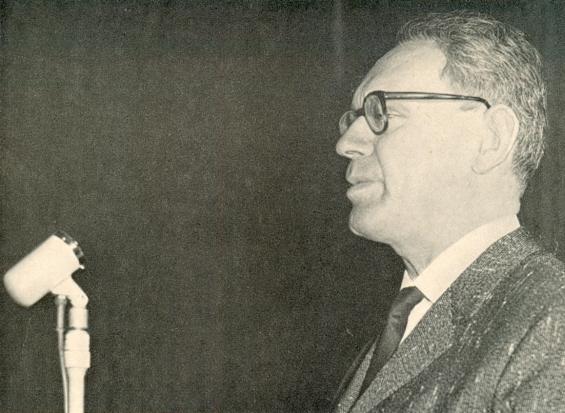
Frontispiece of Botwinnik lehrt Schach by Hans Müller (Berlin-Frohnau, 1967)
7138. Fast chess
Vladislav Tkachiev (Moscow) draws to our attention his new website WhyChess, which takes a particular interest in blitz chess.
Our correspondent raised a number of questions on the subject in C.N. 2231 (see page 71 of A Chess Omnibus), and we have now brought together that item and other relevant material in a feature article, Fast Chess.
7139. Raubitschek/Raubitscheck
John Hilbert (Amherst, NY, USA) asks what can be found concerning Robert/Rudolf/Rudolph Raubitschek/Raubitscheck. The two spellings of the surname were used more or less interchangeably by the American Chess Bulletin during the relevant period (the first two decades of the twentieth century). The only information in the entries for Robert and Rudolf in Jeremy Gaige’s Chess Personalia is that the former was born in Vienna on 1 November 1876. Our correspondent comments:
‘It appears that databases invariably have “Rudolf Raubitschek” instead of “Robert Raubitschek” when giving games by a player with this surname.’
Two games included in Capablanca’s My Chess Career were nonetheless clearly ascribed to Robert in that book. For photographs of him see C.N.s 3980 and 6458. There was a mention of ‘Mr Robert Raubitschek’ on page 20 of the June 1897 American Chess Magazine, and ‘Rudolph Raubitscheck, New York. Robert Kaubitscheck [sic], New York’ appeared in the alphabetical list of subscribers to Cambridge Springs, 1904 on page 30 of the June 1904 American Chess Bulletin.
Below is a reference to ‘the Raubitschek brothers’ on page 181 of the July-August 1919 American Chess Bulletin:
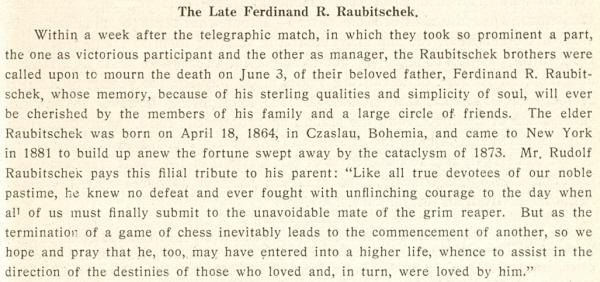
The respective birth-dates given for Ferdinand and his son Robert (1864 and 1876) are not possible. That 1864 was a misprint for 1846 is indicated by the data available (from the 1905 New York State census) at the FamilySearch.org website:
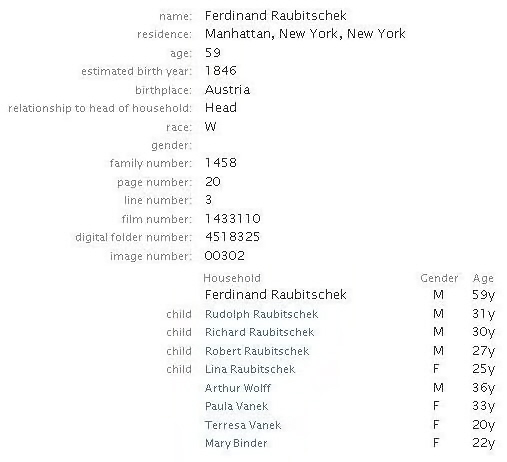
Even so, a discrepancy exists over Robert’s age; if he
was 27 in 1905, the year of birth given by Gaige (1876) is
incorrect. In fact, the 1942 draft registration card
available at the same website states that Robert was born
on 1 November 1877.
Much remains to be researched, but it seems clear, at least, that the spelling Raubitscheck is now to be avoided.
7140. Koltanowski
The FamilySearch.org website mentioned in the previous item has a reference to Georges Gustave Koltanowski. The ‘Gustave’ was news to us.
7141. Petrosian v Botvinnik
Rick Massimo (Providence, RI, USA) points out a remark by Igor Botvinnik about his uncle on page 9 of Botvinnik-Petrosian The 1963 World Chess Championship Match (Alkmaar, 2010):
‘I had the impression that he did not like to be reminded of this match loss, and it was a subject we hardly ever spoke about. However, when he occasionally talked about the pre-match negotiations, and the story of Petrosian’s sealed move in Game 5, he did say that his nerves had been “preyed upon”.’
Finding no information elsewhere in the book regarding an incident in the fifth game, Mr Massimo asks what happened.
Botvinnik gave the following account on pages 171-172 of Achieving the Aim (Oxford, 1981):
‘I played the match not too well. A definite effect on my state of mind was produced by an incident in the fifth game. At the start of the adjourned session (the game was adjourned in a winning position for Petrosian) the judge Golombek (England) opened the envelope and, after looking at Petrosian’s score sheet, made a losing [sic] for Petrosian. The latter protested energetically; then Golombek shrugged his shoulders and made the move which my opponent insisted on.
After my loss in this game I approached Golombek for an explanation (according to the rules if the judge is doubtful about which move has been made, i.e. if there is an inaccuracy in the writing, then a loss is awarded). Golombek replied that the move was indeed not clear, but he was not in agreement with such an interpretation of the rules. I was infuriated. This legal point had been decided when I was still a young man. I approached Ståhlberg – he supported the position of his colleague.
Then I demanded a photocopy of the score sheet. This was provided a week later. All week I was nervous and managed to lose yet another game. However, the unpleasantness lay in the fact that although Petrosian had written the move down inaccurately there could be no doubt about deciding what move had been sealed, and Petrosian had complete justification for his protest at the adjournment.
I felt bitter at my old friends, the match judges. I just couldn’t understand why they had created such a groundless conflict.’
Golombek covered the match for the BCM, with much detail on matters large and small, but we see no reference to this adjournment incident. Petrosian’s sealed move was 41 Kf7. Is it known whether his score-sheet for the game has survived?
7142. H.G. v Machine
A late specimen of Harry Golombek’s play was given in his column in The Times on 17 January 1981, page 10. Despite supplying a detailed description of the computer against which he had been pitted ‘recently’, he merely named it in the game heading as ‘Machine’.
Harry Golombek – ‘Machine’1980 or 1981
English Opening
1 c4 Nf6 2 Nf3 e6 3 Nc3 Bb4 4 Qb3 Nc6 5 a3 Bxc3 6 Qxc3 d6 7 b4 Bd7 8 Bb2 O-O 9 e4 e5 10 d4 exd4 11 Nxd4 Re8 12 f3 Nxd4 13 Qxd4 Qe7 14 Be2 a6 15 O-O Rad8 16 Rac1 Qe5 17 Qxe5 dxe5 18 Rfd1 Re6 19 Bf1 c6 20 Rd2 Rde8 21 Rcd1 R6e7
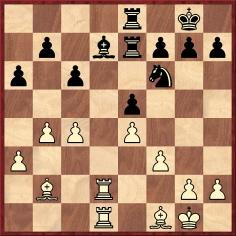
22 a4 Rd8 23 b5 c5 24 Rd6 axb5 25 cxb5 Ra8 26 Ba3 Rxa4 27 Bxc5 Be6 28 Rd8+ Re8 29 Rxe8+ Nxe8 30 Rd8 g6 and White won.
After Black’s 30th move Golombek commented:
‘Here it looked at first R-R7, then B-Q2, P-R3 and P-B4 and then back to P-R3 and P-KN3. It spent 29 minutes 44 seconds on this hopeless procedure and staggered on for another ten moves before I mated it.’
7143. Legall (C.N.s 5720 & 5734)
Dominique Thimognier (Fondettes, France) notes that French départements are placing online an increasing number of archive documents. Regarding the birth-date of Legall given in C.N. 5734 he has found confirmation in the Versailles register of christenings for 1702. The text reads (regarding 4 September 1702):
‘Du même jour
François Antoine De Legal
François Antoine né ce jourdhuy fils de Mr René François de Legal Chevalier Maréchal des camps et armées du Roy et de Dame Françoise Marie de Vitart St Clair son épouse a été baptisé par moy soussigné ...’
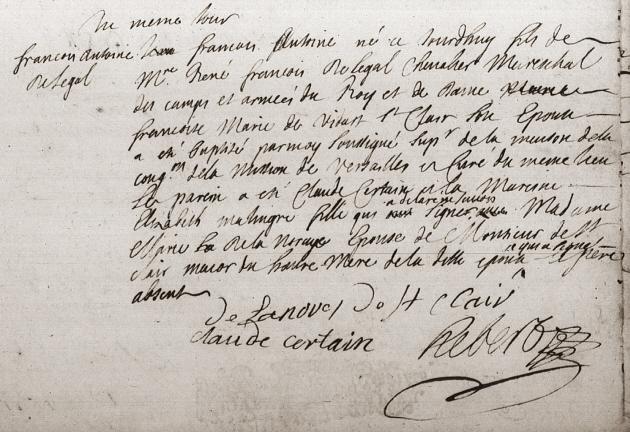
It is of particular interest to see the forenames, François Antoine, with the family name spelt De Legal. Our correspondent notes too the statement at the conclusion of the document that François Antoine’s father was away.
He has also found the baptism record of François Antoine’s younger brother, who was born on 14 April 1705. It bears the signature of their father, René François, who wrote his name ‘de Legall’ on that occasion:

7144. USA v USSR match
Concerning the USA v USSR match in New York in 1954, Luc Winants (Boirs, Belgium) draws attention to a fine selection of photographs by Alfred Eisenstaedt from Life which can be viewed online.
Noting that Bobby Fischer was a spectator at all four
rounds of the event, as reported on page 33 of Endgame
by Frank Brady (New York, 2011), our correspondent wonders
whether the boy can be spotted in any shots of the
audience.
7145. Nardus sketches (C.N. 7104)
Four further sketches by L. Nardus at Scheveningen, 1913 were published on page 311 of The Field, 9 August 1913:
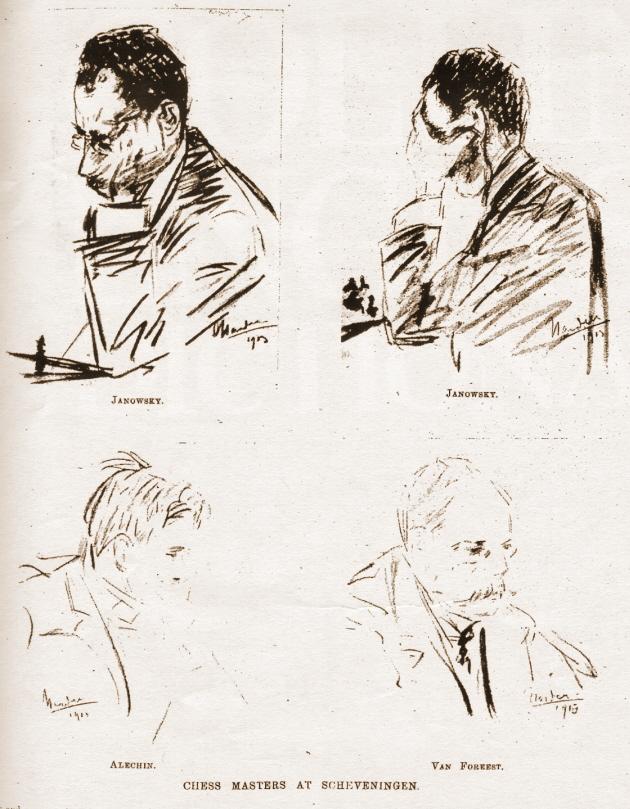
7146. Petrosian v Botvinnik (C.N. 7141)
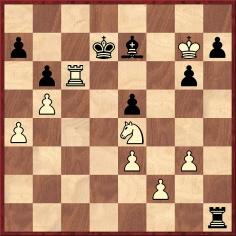
White to move (adjournment position)
Peter Wood (Hastings, England) cites the note to 41 Kf7 on page 147 of Tigran Petrosian His Life and Games by Vik L. Vasiliev (London, 1974):
‘Undoubtedly the strongest, which unexpectedly called forth a protest from the opponent. Here Botvinnik turned to the match arbiter and claimed that White had sealed the impossible move 41 K-B8?? (into check!).
One of Petrosian’s “small weaknesses” is that he has a habit of writing the number 7 with a round tail ... in a word, the mediation of the judge was called for, and after the truth of the matter was established, play continued. The nervous strain of a hard match sometimes produces the most unexpected conflicts!’
7147. Atkins v Jacobs (C.N. 7096)
Alan Smith (Manchester, England) mentions that an Atkins v Jacobs game was published on page 32 of the Illustrated London News, 1 January 1916:
1 e4 d5 2 exd5 Nf6 3 d4 Qxd5 4 Nc3 Qa5 5 Nf3 c6 6 h3 Bf5 7 a3 Nbd7 8 Bd2 e6 9 Bc4 Qc7 10 Be3 Bd6 11 Bd3 Bg6 12 Qd2 O-O 13 Bxg6 hxg6 14 Ng5 Rfd8 15 Nce4 Be7 16 Nxf6+ Nxf6 17 Bf4 Qb6 18 c3 c5 19 dxc5 Bxc5 20 Qe2 Rd5 21 b4 Be7
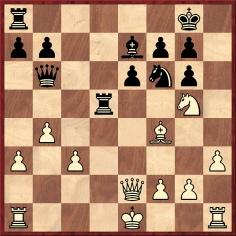
22 c4 Qd4 23 O-O Qxf4 24 cxd5 Qxg5 25 dxe6 Qd5 26 exf7+ Qxf7 27 Rad1 a5 28 Qb5 axb4 29 axb4 Bf8 30 Rd4 Re8 31 f3 Qe6 32 Rfd1 Qe3+ 33 Kh1 Nh5 34 Qd5+ Kh7 35 Rh4 Re6 36 Qd3 Qg5 37 Rg4 Qe5 38 Rh4 Bd6 39 f4 Qf5 40 Qxf5 gxf5 41 Rxh5+ Resigns.
The heading was: ‘Game played in the Championship Tournament of the City of London Chess Club, between Messrs G. [sic] Atkins and H. Jacobs.’
7148. Views on Chess (C.N.s 6714 & 6715)
As noted in C.N.s 6714 and 6715, page 30 of the Observer, 31 October 1937 had the results of a competition entitled ‘Views on Chess’. Below is the full text:
‘The most unexpected entry is that of E.G., who won the British Chess Magazine Correspondence Tournament 25 years ago and gives “as the result of a generation of reflection”, the verdict that “Chess Mastery is the supreme example of concentrated mental power exercised on insatiable futility”.
There are others who harp on the “futility”, but is it not the essence of a game to have no object but itself? The main objection, of course, is to its length. “Thou foster-child of silence and slow Time”, says D.W.; and others quote Macbeth: “Creeps in this petty pace from day to day” (R.L.G.) and “If it were done when ’tis done ’twere well it were done quickly” (W.G.H.). Less formal is L.B.B.: “Too slow, dear, give me tiddley-winks.” Here are one or two other comments critical of one aspect of the game or another:
“Life is too short for chess, but that is the fault of life, not chess.” (H.W.O.)
“A good talk spoiled.” (R.P.)
“The apotheosis of knocking off work to carry bricks.” (H.A.M.)
“Chess demands a concentration of mind which is lost to the world and save for the Clock Rule would be found in Eternity.” (G.S.)
“What a game for the shades!” (E.L.)
“A great and noble game, yet the most unsociable ever invented.” (F.B.)
“A Chinese emperor after seeing a game of chess for the first time said, ‘Call you it a game?’” (A.T.G.)
Here are some other views on various aspects of the game:
“In reality the most delicate portrayal of the working of a man’s mind in existence.” (J.M.)
“The least emotional and most moving of human performances.” (F.C.B.)
“The game of chess, like the game of life, should be taken seriously, but, while the ideal game of chess ends with a mate, the ideal game of life only begins with one.” (J.W.G.)
“Masterly inactivity.” (K.G.)
“The sport of mathematicians, the image of war with none of its guilt and not even one per cent of its danger.” (J.C.D.)
“Chess, in modern jargon, is an escape and – ye gods! – into what?” (K.R.)
“Pooh, that’s easy; it should be played in three dimensions.” (F.W.)
“The game of chess offers the supremest exercise of the mental gymnasium; it is the only contest where accurate thought is supreme and the equation of chance is zero; it is economical, prophylactic, inexhaustible, elegant, cultured, sociable, international, exasperating yet humorous, poignant yet piquant.” (H.M.W.)
“Chess teaches a man to be merciful since the king – his company dispersed and his protection gone – must yet be spared.” (A.J.M.T.)
R.C.G. makes a gallant effort to brighten a serious subject by the entry: “I’m Alekhine at Euwe” (I’m a looking at you).
We award the prize to Professor H.J. Rose, Edgecliff East, The Scores, St Andrews, Fife, who sends the following:
“Intimate conversation without a word spoken; thrilling activity in quiescence; triumph and defeat, hope and despondency, life and death, all within sixty-four squares; poetry and science reconciled; the ancient East at one with modern Europe – that is Chess.”’
We comment on just one of the entries, the description of chess as ‘a good talk spoiled’. This is reminiscent of the observation attributed (though apparently no more than that) to Mark Twain: ‘Golf is a good walk spoiled.’ See page 782 of The Yale Book of Quotations by Fred R. Shapiro (New Haven and London, 2006).
7149. Passport application by Steinitz
At the ancestry.com website Russell Miller (Vancouver, WA, USA) has found a passport application by Steinitz, dated 26 October 1896:
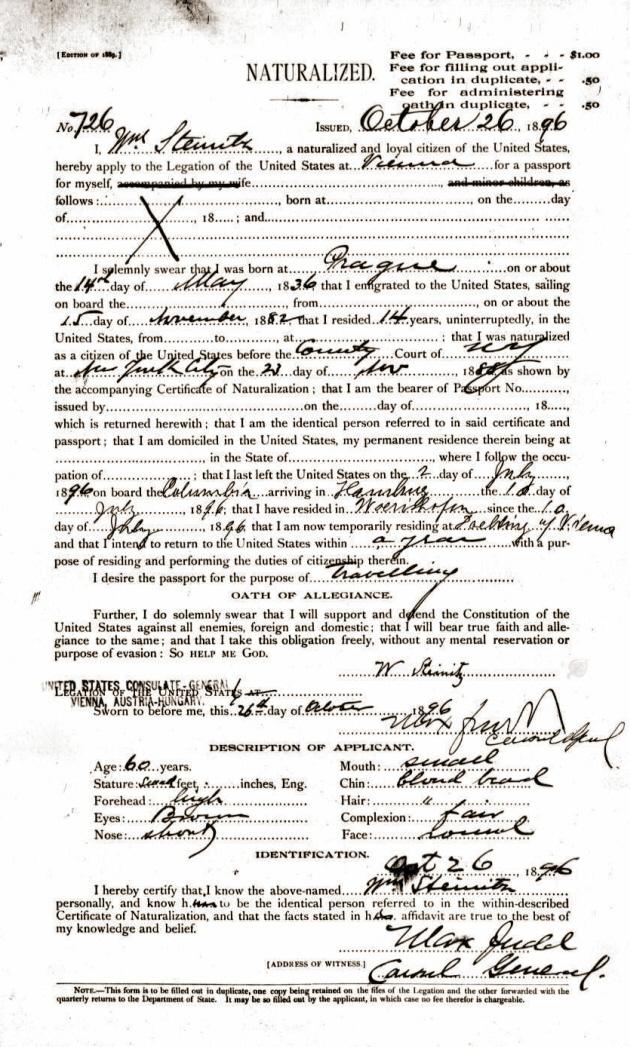
7150. Tal books (C.N. 2722)
Below is an updated list of books about (not by) Tal in our collection:
- El extraordinario ajedrez de Miguel Tal by L. Palau (Buenos Aires, 1960)
- The Unknown Tal by V. Zemitis (San Francisco, 1960)
- Miguel Tal campeón del mundo (Barcelona, 1960 and 1980)
- Selected Games of Mikhail Tal by J. Hajtun (London, 1961 and New York, 1975 and German edition, Düsseldorf, 1961)
- The Chess Psychologist World Champion Tal by A. Liepnieks (Chicago, 1961 and 1975)
- Michail Tal by H. Bouwmeester and B.J. Withuis (Amsterdam, 1961)
- Weltgeschichte des Schachs: Tal (Hamburg, 1961)
- Mikhail Tal’s Best Games of Chess by P.H. Clarke (London, 1961 and 1991)
- Talj by A. Koblenz (Zagreb, 1964)
- Tal Since 1960 by W.H. Cozens (St Leonards on Sea, 1974)
- Tal’s 100 Best Games 1961-1973 by B. Cafferty (London, 1975)
- Tal’s Masterpieces and other Select Games 1960-1975 by A. Karklins (Chicago, 1976)
- Complete Games of Mikhail Tal 1960-66 by H. Thomas (London, 1979)
- Complete Games of Mikhail Tal 1967-73 by H. Thomas (London, 1979)
- Complete Games of Mikhail Tal 1936-1959 by H. Thomas (London, 1980)
- Mihail Talj by D. Marović (Zagreb, 1980)
- Tahl 222 partidas (Madrid, 1990)
- Tal the Magnificent by A. Soltis (Dallas, 1990)
- Mihail Tahl by D. Bjelica (Madrid, 1992)
- Mikhail Tal Games 1949-1962 by A. Khalifman (Sofia, 1994)
- Mikhail Tal Games 1963-1972 by A. Khalifman (Sofia, 1995)
- Mikhail Tal Games 1973-1981 by A. Khalifman (Münster, 1996)
- Mikhail Tal Games 1982-1992 by A. Khalifman (Sofia, 1996)
- Mikhail Tal Tvortshestvo 1962-1967 (Riga, 1998)
- Mikhail Tal Tvortshestvo 1968-1973 (Riga, 1998)
- Mikhail Tahl Biografía 100 partidas magistrales by J. Chiappini (Rosario, 1999)
- The Magic of Mikhail Tal by J. Gallagher (London, 2000)
- Mikhail Tal Tvortshestvo 1974-1979 (Riga, 2001)
- Mikhail Tal Tvortshestvo 1980-1986 (Riga, 2001)
- Mikhail Tal Tvortshestvo 1987-1992 (Riga, 2001)
- Liubov i shakhmaty by S. Landau (Moscow, 2003)
- Mikhail Tal: Zhizn i igra by I. and V. Linder (Moscow, 2008)
- Zaubern wie Schachweltmeister Michail Tal by K. Müller and R. Stolze (Zurich, 2010)
- The Chess Greats of the World: Mikhail Tal by D. Lovas (Kecskemét, 2010).
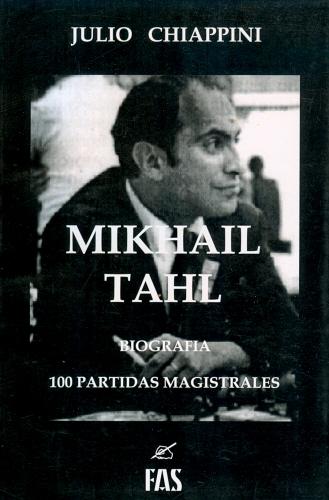
7151.
Teenage author
Which teenager published an annotated collection of Morphy’s games?
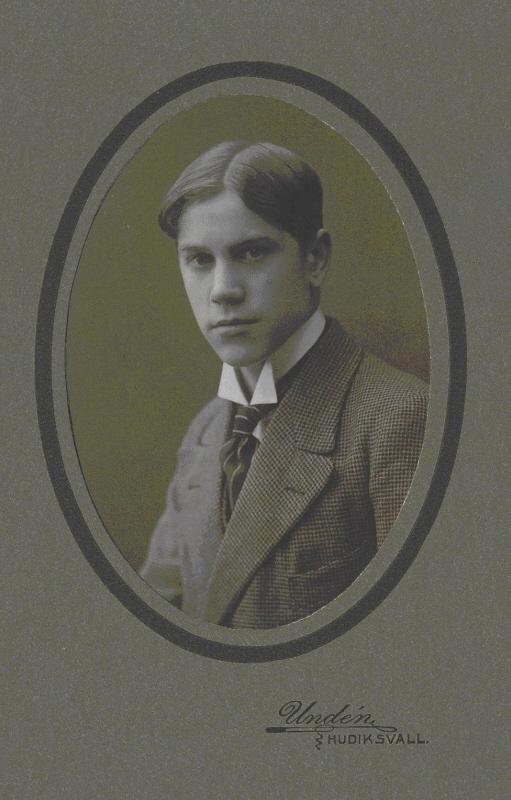
The answer is Bertil Rask, whose monograph Paul Morphy 180 partier (Stockholm, 1915) appeared around the time of his 17th birthday.
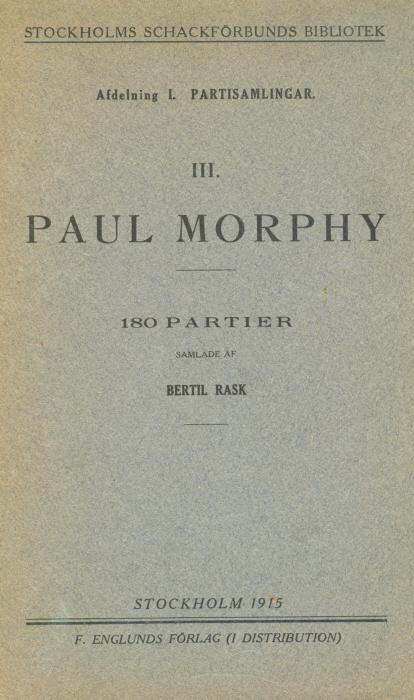
Rask died of tuberculosis in Stockholm in 1918, aged 20. Below is his obituary on page 170 of the August-September 1918 issue of Tidskrift för Schack:
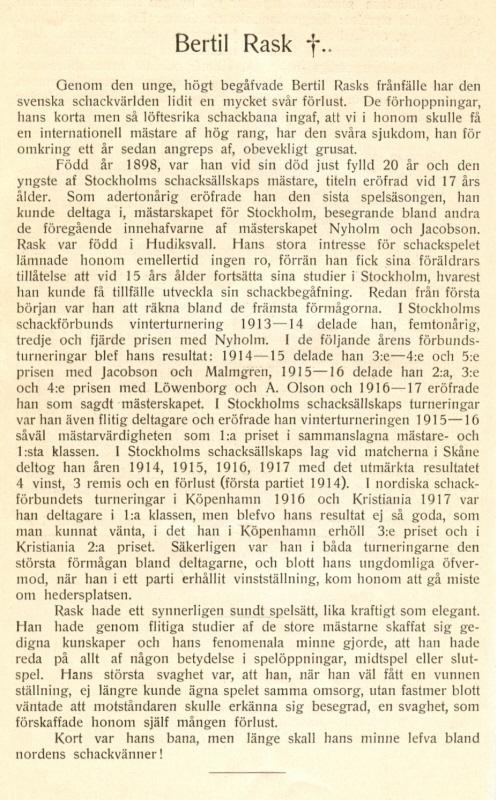
See also pages 392-393 of an admirable 526-page book Stockholms Schackförbund 1911-2011 by Peter Holmgren (Stockholm, 2011). We are grateful to Mr Holmgren for allowing us to reproduce the above portrait of Rask.
7152. Legall (C.N.s 5720, 5734 & 7143)
Joseph Dillon Ford (Gainesville, FL, USA) points out that detailed information about the chessplayer’s ancestors, and particularly his father, is available in the article ‘Legal: L’épopée d’un bourgeois breton sous Louis XIV’ by René de Laigue in the Bulletin archéologique de l’Association bretonne, 1899.
Our correspondent remarks:
‘The marquis was not born into the aristocracy but began life as René-François Le Gal, the son of a wealthy Breton. He distinguished himself in the War of the Spanish Succession and as a result of his military prowess won the grateful admiration of Louis XIV.’
We shall be pleased to forward to interested readers a number of links to publications available at Google Books which have been traced by Mr Ford.
7153. Alekhine and Euwe snippet
Robert Sherwood (E. Dummerston, VT, USA) draws attention to a snippet of film showing Alekhine and Euwe at the chessboard (the first part of the item).
7154. Streets named after chessplayers
In C.N. 725 (see page 106 of Chess Explorations) a correspondent mentioned that Tallinn has a ‘Paul Keres Street’.
Harrie Grondijs (Rijswijk, the Netherlands) reports that it is a wide lane. He was there recently:
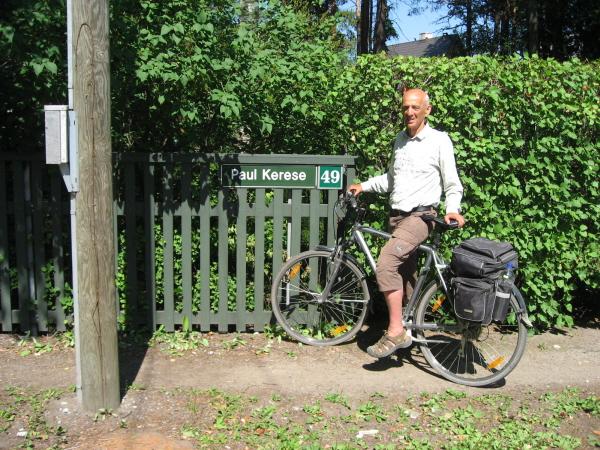
7155. Raubitschek (C.N. 7139)
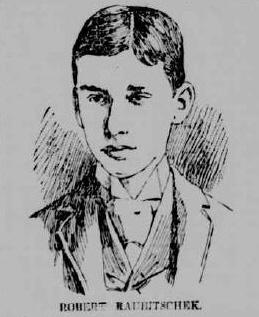
John Hilbert (Amherst, NY, USA) notes that the above sketch of Robert Raubitschek appeared in the New-York Daily Tribune of 21 July 1895, page 22. In that chess article Raubitschek is quoted as saying that he was born on 1 November 1876 (the date given in Gaige’s Chess Personalia).
7156. A. Gibaud
C.N. 3077 (see pages 274-275 of Chess Facts and Fables) asked when A. Gibaud died.
Dominique Thimognier (Fondettes, France) has now found that Gibaud’s birth certificate (he was born in Rochefort on 5 March 1885) has a handwritten addition stating that he died in Rochefort on 18 August 1957.
Our correspondent notes that Gibaud’s forename appears in chess sources as either Aimé or Amédée and that the above-mentioned certificate has the former.
We add a photograph of Gibaud with Alekhine, from the November 1928 issue of L’Echiquier: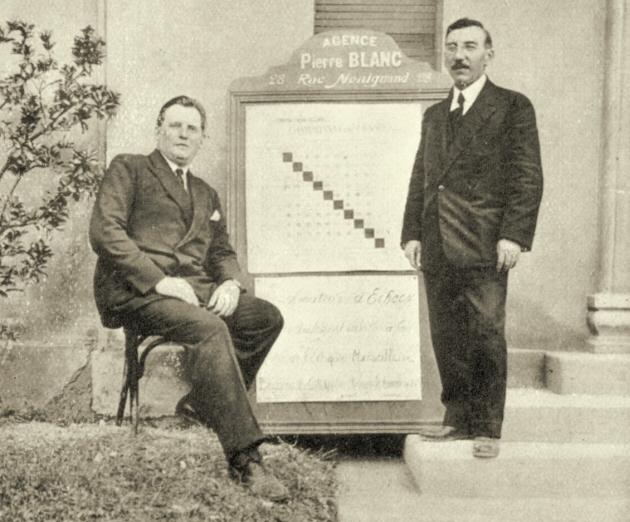
7157. Chessboard grafts (C.N. 4300)
C.N. 4300 quoted a brief item (‘Chess aids medical science’) on page 371 of CHESS, 18 June 1955:
‘Dr P. Gabarro, a prominent Barcelona surgeon is a keen chessplayer. Perhaps that is why the idea struck him that skin grafted on to extensive injured areas might knit better if applied in a chessboard pattern. Anyway, he tried out his “hunch”, and the result, illustrated by grisly but impressive photographs in a recent article by him in the British Medical Journal, has been a great success. “Chessboard grafts” may soon be accepted medical practice.’
We now note what appeared on pages 723-724 of the British Medical Journal, 12 June 1943, available online.
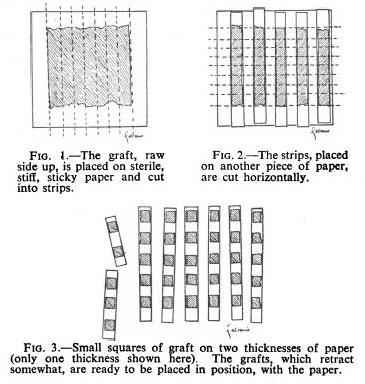
7158. Eliza Campbell Foot
‘... Miss Foot has challenged Mr Steinitz to a game by correspondence, and the contest is now proceeding.’
Drawing attention to this report on page 7 of the South Australian Register, 11 October 1893, Graham Clayton (South Windsor, NSW, Australia) asks whether the game-score has survived.
We do not recall seeing it, although Eliza Campbell Foot’s obituary on pages 253-254 of the December 1914 American Chess Bulletin stated:
‘Miss Foot took special pride in referring to a victory she achieved in years gone by over William Steinitz. The score was printed at the time.’
See also Kurt Landsberger’s books William Steinitz, Chess Champion (Jefferson, 1993) and The Steinitz Papers (Jefferson, 2002). On, respectively, pages 277 and 159 Landsberger quoted a letter dated 4 November 1896 from F.J. Lee to Frideswilde Rowland which was given in the Spring 1911 issue of Four Leaved Shamrock with the following addition by Mrs Rowland:
‘During the seclusion at Upper Montclair, Steinitz was playing a correspondence game with his cousin, Miss Eliza Foot, President of the Women’s Chess Association, New York. She sent me a copy of her game with Steinitz wherein he resigned, but Dr Pollock told me afterwards that Steinitz played the game without looking at the board.’
On page 286 of The Steinitz Papers Landsberger wrote concerning Miss Foot:
‘She was not related to Steinitz, but was a good friend.’
This photograph was published on page 102 of the June 1906 American Chess Bulletin:
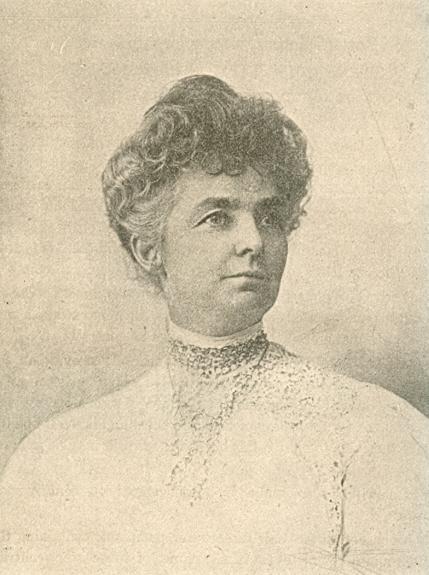
Her above-mentioned obituary reported that she died near the Manhattan Chess Club on 6 December 1914:
‘It was a very stormy evening and, carrying an umbrella, Miss Foot evidently was at a great disadvantage with respect to any vehicles that might be passing. One suddenly bore around the corner at high speed, killing her outright. The fact that the driver of the machine made his escape placed the tragedy on the same plane as a wanton, cold-blooded murder.’
7159. Monte Carlo, 1902
This group photograph comes from page 65 of Tempêtes sur l’échiquier by François Le Lionnais (Paris, 1981):
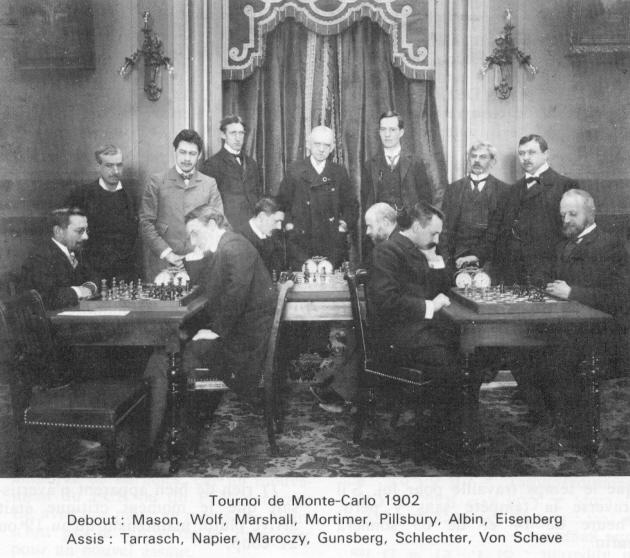
7160. Franklin Russell
John Blackstone (Las Vegas, NV, USA) has found this article on page 9 of the Brooklyn Daily Eagle, 27 January 1907:
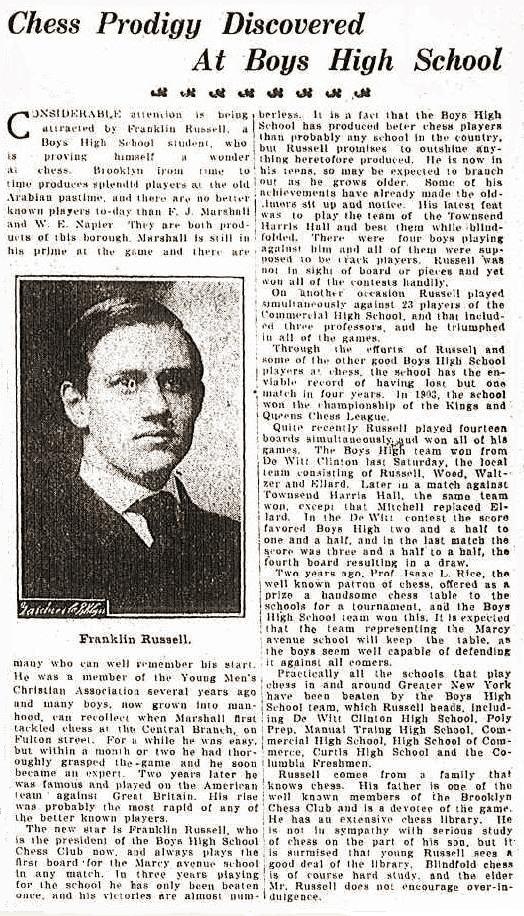
We note that the photograph was also published on page 214 of the November 1907 American Chess Bulletin:
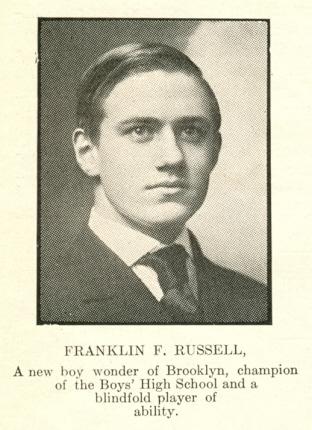
From page 301 of A Century of British Chess by P.W. Sergeant (London, 1934):
‘In 1912 the Rhodes Scholar, Franklin F. Russell (Brasenose), played top board for Oxford for the first of three years in all, in each of which he scored a draw. He was an American, from Brooklyn High School, and came up to Oxford with a chess reputation already made.’
Previously Russell had attended New York University, and this specimen of his play comes from a college team match:
Louis Tolins (Cornell University) – Franklin Ferriss Russell (New York University)New York, 3 January 1910
Sicilian Defence
1 e4 c5 2 Nf3 e6 3 Nc3 Nc6 4 d4 cxd4 5 Nxd4 Nf6 6 Be3 Bb4 7 Bd3 d5 8 Nxc6 bxc6 9 e5
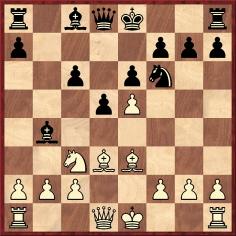
9...d4 10 O-O Ng8 11 Be4 dxe3 12 Bxc6+ Bd7 13 Bxa8 exf2+ 14 Kh1 Qxa8 15 Rxf2 Bc5 16 Re2 Bc6 17 Qd3 Ne7 18 Ne4 Bxe4 19 Rxe4 O-O 20 Rh4 Nf5 21 Re4 Rd8 22 Qe2 Nd4 23 Qg4 Nxc2 24 Rc1 Bb6 25 h3 Ne3 26 Qf3 Nf5 27 Kh2 Bd4 28 b3 Qb8 29 Qe2 f6 30 Rd1 Bxe5+ 31 Rxe5 fxe5 32 Rxd8+ Qxd8 33 Qxe5 Qd6 34 White resigns.
Source: American Chess Bulletin, February 1910, pages 40-41.
As noted in Jeremy Gaige’s Chess Personalia, Russell lived from 1891 to 1978. He had a distinguished academic career in law. His father, Isaac Russell (1857-1931), who was Chief Justice of Special Sessions, expressed positive comments about chess in an interview quoted on page 152 of the July 1912 American Chess Bulletin. Franklin’s brother William M. Russell was a frequent contributor to the Bulletin; his obituary on page 118 of the September-October 1950 issue discussed the family connections.
7161. Three Cuban brevities
The games below were given, respectively, in C.N.s 1363, 1368 and 1513:
Rogelio Ortega – José Luis Barreras MeriñoHavana, 10 August 1946
Budapest Defence
1 d4 Nf6 2 c4 e5 3 dxe5 Ng4 4 Qd4 d6 5 exd6 Bxd6 6 Nc3 O-O 7 Nf3 Nc6 8 Qd1 Nce5 9 Nd4 Re8 10 e3 Bb4 11 Qc2
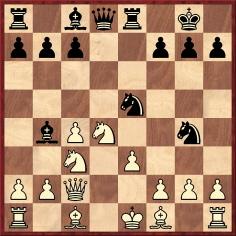
11...Qxd4 12 exd4 Nf3+ 13 Kd1 Re1 mate.
Source: Ajedrez en Cuba by C. Palacio (Havana, 1960), pages 264-265.
Luis R. Díaz – Miguel ValladaresCuban Correspondence Tourney, 1972
Irregular Opening
1 Nf3 e5 2 Nxe5 Nc6 3 Nxc6 dxc6 4 d4 Bd6 5 e4 Qh4 6 Nc3 Bb4 7 Bd3 Nf6 8 Bd2 Bxc3 9 Bxc3 Nxe4 10 Qe2
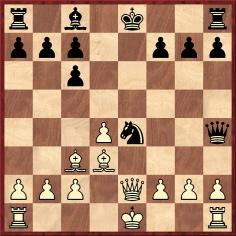
10...f5 11 O-O O-O 12 g3 Qh3 13 Bxe4 fxe4 14 Qxe4 Bf5 15 Qf4 Bg4 16 White resigns.
Source: Jaque Mate, 7-8/1973, page 66.
C.N. 2454 (see page 173 of A Chess Omnibus) pointed that although Jaque Mate had used the term ‘Valladares Opening’, a game between von Scheve and Silbert at the Café de la Régence in Paris on 24 October 1902 had begun 1 Nf3 e5 2 Nxe5 d5 3 d4 Bd6. Janowsky called Black’s first move ‘a very rare error in a tournament game’ (La Stratégie, 21 January 1903, pages 4-5). Moreover, 1…e5 in reply to 1 Nf3 was played even by Emanuel Lasker, in a 1907 simultaneous game (a win) in Topeka. He published it – under the heading ‘Opening: (Original!)’ – on page 151 of the August 1907 issue of Lasker’s Chess Magazine.
José Antonio Gelabert y Barrueté – Evelio BermúdezOccasion?
King’s Gambit Accepted
1 e4 e5 2 f4 exf4 3 Nf3 Be7 4 Bc4 Bh4+ 5 g3 fxg3 6 O-O gxh2+ 7 Kh1 Be7 8 Bxf7+ Kxf7 9 Ne5+ Ke8 10 Qh5+ g6
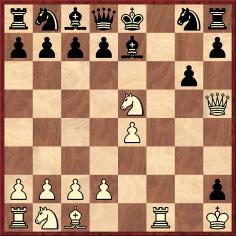
11 Nxg6 Nf6 12 Rxf6 Bxf6 13 Ne5+ Ke7 14 Qf7+ Kd6 15 Nc4+ Kc5 16 Qd5+ Kb4 17 a3+ Ka4 18 b3 mate.
Source: Revista Cubana de Ajedrez, September-October 1923, page 23.
7162. How many masters?
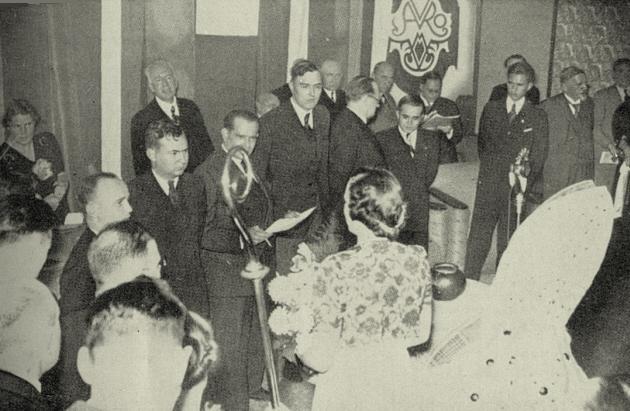
In this photograph how many masters can be identified?
7163. Foot v Steinitz (C.N. 7158)
John Blackstone (Las Vegas, NV, USA) has found the Foot v Steinitz game on page 9 of the Brooklyn Daily Eagle, 14 November 1909:
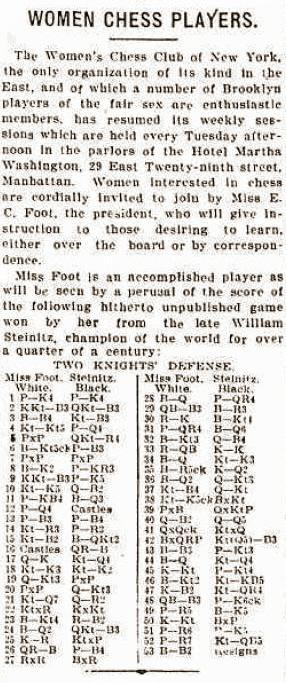
1 e4 e5 2 Nf3 Nc6 3 Bc4 Nf6 4 Ng5 d5 5 exd5 Na5 6 Bb5+ c6 7 dxc6 bxc6 8 Be2 h6 9 Nf3 e4 10 Ne5 Qc7 11 f4 Bd6 12 d4 O-O 13 c3 c5 14 Na3 a6 15 Nc2 Bb7 16 O-O Rac8 17 Qe1 Nd5 18 Ne3 Ne7 19 Qg3 cxd4 20 cxd4 Qb6 21 Nd7 Qa7 22 Nxf8 Kxf8 23 Bg4 Rc7 24 Bd2 Nac6 25 Kh1 Nxd4 26 Rac1 f5 27 Rxc7 Bxc7 28 Bd1 a5 29 Bc3 Ba6 30 Re1 Bb5 31 a4 Bd3
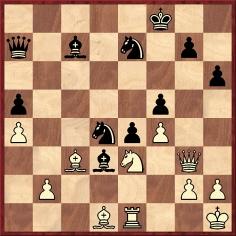
32 Bb3 Qc5 33 Rc1 Ke8 34 Bd1 Ne6 35 Bh5+ Kd7 36 Bd2 Qb6 37 Nc4 Qb8 38 Ne5+ Bxe5 39 fxe5 Qxb2 40 Qf2 Qd4 41 Qxd4+ Nxd4 42 Bxa5 Ndc6 43 Bc3 g6 44 Bd1 Nd5 45 Kg1 g5 46 Bb2 Nf4 47 Kf2 Na5 48 Bc3 Nc4 (The move order given by the newspaper for the remainder of the game was garbled.) 49 a5 e3+ 50 Kg1 Be4 51 a6 Bxg2 52 a7 Be4 53 Bc2 Resigns.
7164. Camelot
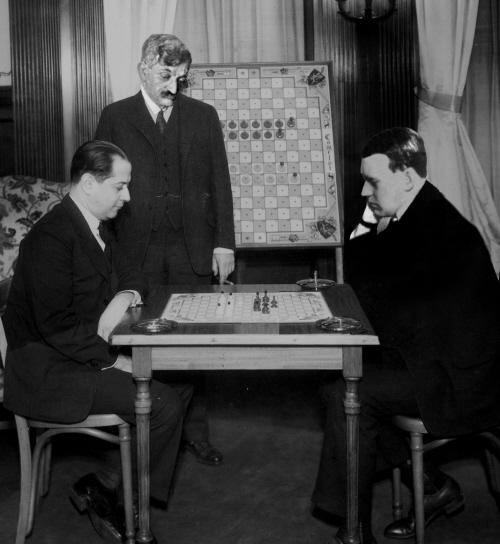
The above photograph (Capablanca, Lasker and Alekhine) comes from a webpage of the World Camelot Federation, and we reproduce it with the permission of the Federation’s President and Founder, Michael Nolan (Troy, MI, USA). He informs us that he created it on the basis of this picture:
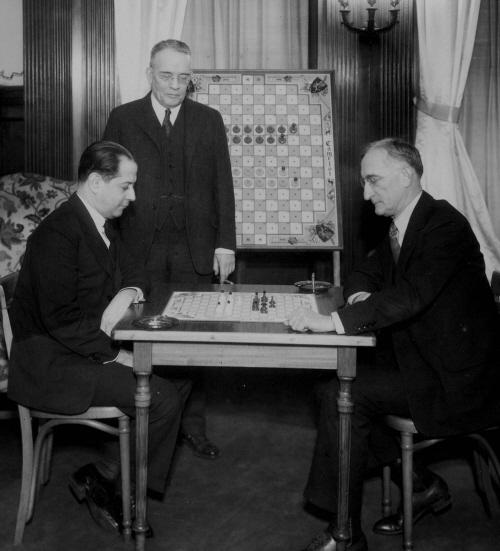
Here, Capablanca’s opponent is the Camelot and bridge expert Sidney Lenz, while E.V. Shepard (another bridge authority) looks on.
On the subject of Capablanca and Camelot see C.N. 2452 on page 172 of A Chess Omnibus. That item included a quote by Capablanca about the game from a 1930s rules booklet:
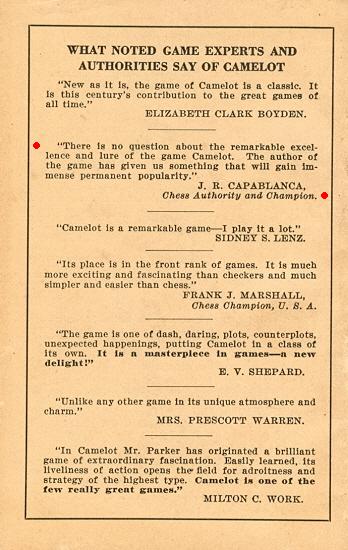
Additional quotes about Camelot are given on another webpage of the World Camelot Federation.
See too our article A Fake Chess Photograph.
7165. What is Zugzwang?
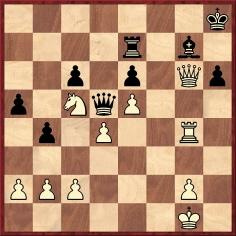
White played 36 b3
In 1985 (C.N.s 923 and 988) David Hooper and Hugh Myers debated the exact meaning of Zugzwang. We have just added their full exchanges in our feature article Zugzwang.
7166. Eliskases v Richter
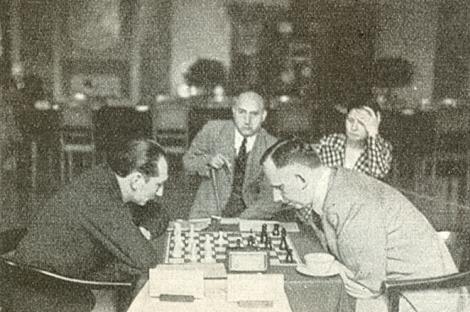
This photograph of Erich Eliskases and Kurt Richter shows their game in the German Championship in Bad Oeynhausen, 14 July 1939.
Source: Deutsche Schachzeitung, August 1939, page 226.
7167. Franklin Russell (C.N. 7160)
Leonard Barden (London) writes:
‘In the mid-1970s I reported on that year’s Oxford v Cambridge match in my column in The Field. I received a letter from Franklin Russell, who told me of his participation in 1912-14. Cambridge could award half-blues but Oxford could not, so Russell’s team made an unsuccessful application to the Oxford Blues Committee. He asked if the situation had changed since he played, and I had to tell him that there had been several such applications over the years, but all had been rejected.
He then told me that the Oxford players of his time had created a special award of “representative colours” for their team along with a multi-coloured tie which the team wore at the match. He was keen that this initiative should be revived, and sent the Oxford team for the next year’s match a batch of seven ties, asking that they be worn. He also sent a tie, which I no longer possess, to me. Alas for his enterprise, by the mid-1970s dress attitudes were becoming more casual and only two or three of the Oxford team wore the Russell tie at the match.’
Page 152 of the April 1914 BCM stated:
‘The Oxford team has been largely made what it is by the influence and example of Mr Russell, whose loss will be greatly felt when he returns to his native air ...’
He returned home to the United States on 4 July 1914 (American Chess Bulletin, September 1914, page 205).
7168. Sultan Khan and Miss Fatima
Olimpiu G. Urcan (Singapore) has found this photograph on page 5 of The Times of India, 16 January 1934:
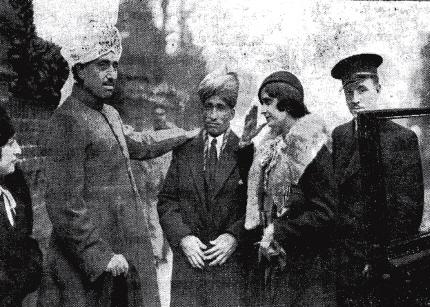
The caption reads: ‘Colonel Sir Umar Hyat Khan bidding farewell to Miss Fatima and Sultan Khan, the Indian Chess champions, when the[y] left London for Tilbury, on their return to India.’
7169. Blindfold knight tour
From page 477 of the December 1913 BCM:
‘On 16 October, at the Colchester Chess Club, Mr A.C. Robst gave an interesting blindfold performance of the knight’s tour. He first gave the tour with a single knight from any square, then with two knights, and finally with four knights simultaneously. This last is a feat which has not to our knowledge been previously attempted blindfold. The board was not numbered, Mr Robst named the squares in the English notation.’
7170. St Petersburg Chess Club
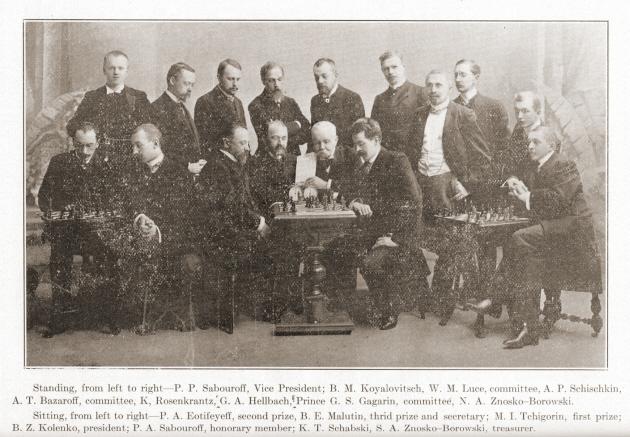
Source: American Chess Bulletin, May 1906, page 88. The occasion was the St Petersburg Chess Club Rice Gambit Tourney.
7171. Altschul v Marshall
‘An interesting ending’ was Marshall’s conclusion in his notes to the following game, played against Frank Altschul (1887-1981), a prominent banker and philanthropist:
Frank Altschul – Frank James MarshallSimultaneous exhibition, New York, 3 August 1938
Ruy López
1 e4 e5 2 Nf3 Nc6 3 Bb5 a6 4 Ba4 Nf6 5 O-O Be7 6 c3 b5 7 Bc2 O-O 8 d4 d6 9 h3 h6 10 d5 Nb8 11 Be3 Nbd7 12 Nbd2 Bb7 13 a4 c6 14 dxc6 Bxc6 15 axb5 axb5 16 Rxa8 Qxa8 17 Qa1 Qb7 18 Qa7 Qxa7 19 Bxa7 Ra8 20 Be3 Ra2 21 Rb1 d5 22 Bb3 Ra8 23 exd5 Bxd5 24 Bd1 Ne4 25 Nxe4 Bxe4 26 Rc1 f5 27 Nd2 Bc6 28 b4 f4 29 Bc5 Nxc5 30 bxc5 Bxc5 31 c4 b4 32 Nb3 Be7 33 c5 Ra3 34 f3 Ba4 35 c6 Bd6 36 Nc5 Bxd1
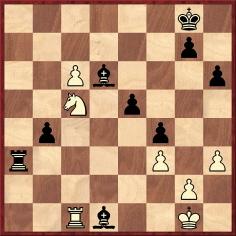
37 Ne4 Bc7 38 Rxd1 b3 39 Rb1 Kf7 40 Nd2 Bb6+ 41 Kf1 Ra2 42 Rxb3 Rxd2 43 Rxb6 Rc2 44 Rb7+ Kf6 45 Rc7 g5 46 Rc8 Ke6 47 Rh8 Rxc6 48 Rxh6+ Kd5 49 Rh5 Drawn.
Source: Chess Review, September 1938, page 221.
A small picture featuring Altschul was published on page 259 of the November 1938 Chess Review:
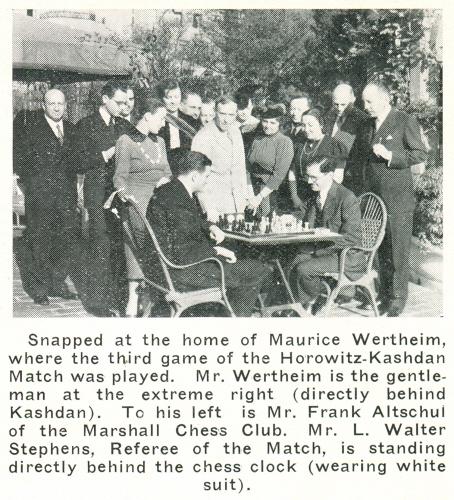
7172. Krejcik position
C.N. 1050 (see pages 9-10 of Chess Explorations) gave this position from a fast game (Krejcik v N.N., occasion unknown):
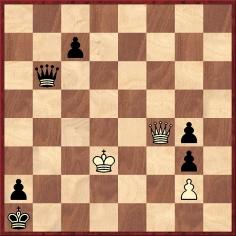
1 Qc1+ Qb1+ 2 Kd2 c6 3 Kd1 c5 4 Kd2 c4
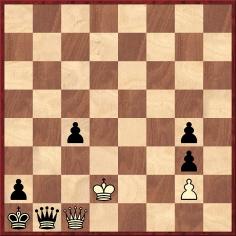
5 Ke2 c3 6 Kd1 c2+ 7 Kd2 Qxc1+ 8 Kxc1 stalemate.
John Nunn (Chertsey, England) points out that the position appears as a study (1923, ‘source unknown’) in the latest van der Heijden study database.
What more can be discovered about the position? At the moment we have only the source specified in C.N. 1050, i.e. page 231 of the August 1924 Wiener Schachzeitung:
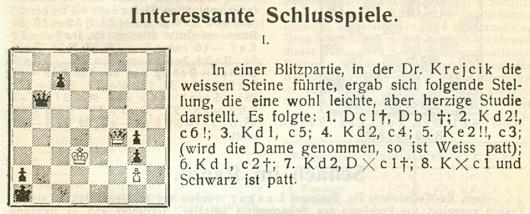
7173. FIDE history
Our latest feature article is Chess: The History of FIDE.
7174. Streets named after chessplayers
(C.N. 7154)
Wijnand Engelkes (Zeist, the Netherlands) reports that he has visited the Rua Alexander Alekhine in Estoril, Portugal:
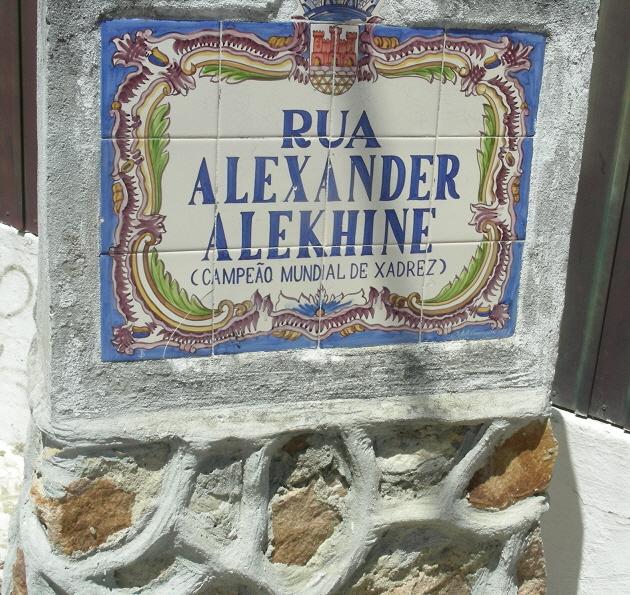
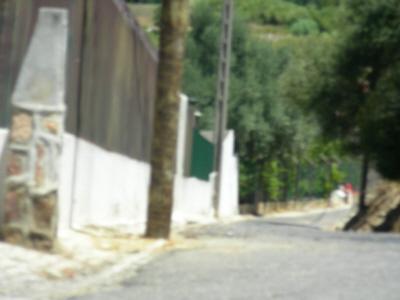
Our correspondent comments:
‘The Rua Alexander Alekhine is beyond the tourist area of Estoril (city of Cascais) and a half-hour walk from the São João railway station. The street-sign is on the stone object on the left of the second picture. The Rua Alexander Alekhine is a small road on a slope, located at a high point in Estoril. There are no houses. On one side are the backs of the houses of an adjacent road, whereas the other side is empty land. There is really nothing there apart from a lonely tree at the top of the hill.’
7175. Frederick Yates
C.N. 780 discussed the claims/rumours surrounding the death of Frederick Dewhurst Yates (1884-1932). See pages 118-119 of Chess Explorations, as well as a ChessBase item written by us in 2008.
The following article by G.H. Diggle originally appeared in the December 1982 Newsflash and was also given on page 89 of Chess Characters (Geneva, 1984):
‘Just 50 years ago the BCM (December 1932) reported the tragic death of F.D. Yates at the age of 48. “On the night of Tuesday, 8 November he gave a very successful exhibition at Wood Green, only dropping one half point in 16 games. On the following night he was in the company of a chess friend until fairly late, and then went back to his room at Coram Street, Bloomsbury. He was never seen again alive. ... he was in the habit of secluding himself for many hours at a stretch when busy with work.” It was not until Friday morning that, after a smell of gas had been noticed, his door was broken open and he was found dead in bed. The cause of death was asphyxiation through a faulty and obsolete gas connection.
Yates lived and died at a time when both press coverage of chess and remuneration of its professionals were at low ebb. The “story” of his end, however, briefly attracted the newsmen, and a few lugubrious “paras” appeared about the poor little Yorkshireman (found dead in his obscure bedsitter) “whose whole life”, according to one reporter, “had been played out on the squares of a chessboard”.
But the chess literature of the time contains many tributes to the man who was six times British champion, and a feared and respected opponent in international chess for over 20 years (spanning from Hamburg, 1910 to San Remo, 1930). He never won a first prize in any great “international” and indeed seldom came high up the list – his aggregate results for the 22 big tournaments in which he played were 85 wins, 85 draws, 119 losses. But it was as a winner of magnificent individual games against the “top brass” that he will be remembered – “the harder the opposition”, wrote P.W. Sergeant, “the better his play”. He excelled in what might be called “long game brilliance”. Alekhine declared in 1930 that Vidmar v Yates (San Remo) was “the greatest game played since the (1914-18) War”. In another tremendous effort against Alekhine himself (Carlsbad, 1923) Yates revealed (says H.G.) “iron pertinacity” in a combination 20 moves deep – “only a great poet of the chessboard”, says Reinfeld, “could have conjured up such a position”. In this game Yates did not hurry his attack, and the “fun” began towards the 40th move. But even if an adjournment may have helped the “conjurer”, the vast network through which the “rabbit” had to travel before being finally produced was truly remarkable.
Neither as a chess personality nor even as a chess Bohemian (which he certainly was) did Yates make the most of himself, being handicapped in the one case by a quiet reserve and in the other by an inability to go quite the whole hog – he lacked the untrammelled panache of Winter or La Bourdonnais. He only “opened out” to a few intimate friends. “They at least”, wrote Sergeant, “knew his widespread interest in other things.” (Yates was a good pianist, and a fine article by him on “Why Chess Appeals to the Intellect” (BCM, 1914 extracted from the Yorkshire Evening Post) attests his high qualifications as a writer.)’
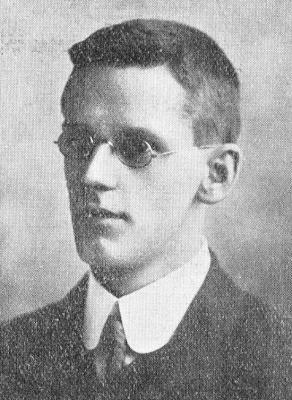
Frederick Dewhurst Yates (BCM, September 1913, page 361)
The Yates article mentioned by Diggle was published on pages 218-220 of the June 1914 BCM, having originally appeared in the Yorkshire Evening Post of 14 May 1914. The full text:
‘Why Chess Appeals to the Intellect
The chess master has many advantages, even if he meets with his due share of disappointments, without which, of course, he would fail to appreciate the good things that fall to his lot. Among other things he can rely on the game as on a passport in practically every city in Europe. It will bring him at once into touch with some sympathetic spirit, who, for no other reason than the good fellowship of the game, will extend just the right amount of hospitality to make the stay an easy and pleasant one.
On all the great sea routes, where one meets so many nice people one never meets again, chess proves an interesting means of companionship, and one of the greatest boons in breaking the tedium of a long journey. But its main advantage lies in bringing interesting types of men together. Without geographical limits, the game has devotees even in the most inaccessible regions and, by the way, the rules under which it is played are uniform throughout the world with the exception of Japan, China and the Eastern Archipelago. One may casually meet in the street, as has actually happened in a day, a champion from Cairo, a leading player from Shanghai, and another whose keenest recollection was of a game he had played at the highest point of a certain pass in the Rockies. On these occasions, conversation left chess severely alone, but generally the chess master is continually asked all manner of questions on all conceivable points of the game.
Even blindfold play still strikes the public equally with other mysteries that cannot satisfactorily be explained, yet not to the extent it formerly did, when it was considered almost a “black art”. But curiously enough, the question most often put is the least important of all. “Do you sleep well after a hard game?” This question is often propounded by a player who is totally incapable of playing a hard game, and in that case can serve no useful purpose to the questioner. As a matter of fact, the harder the game the sounder the sleep, as is the case in all other forms of exertion.
Then there is another question raised, very rarely nowadays, and then rather sheepishly, for on reflection it will be seen that it is not complimentary when addressed to a player. “Does chess ever affect the brain in any way?” This second question is hardly worth discussing, but as these remarks are addressed to a much larger audience than that made up only by chessplayers, it may be as well to point out that in an average population the mentally afflicted are in a proportion of about one in 500, while in a wide experience of chessplayers, covering hundreds who could hold their own with experts and thousands of medium chessplayers, it is not noticeable that the weak-minded are in anything the same proportion. Chess is eminently the game for the level-headed, and the players are those quiet people who are the salt of the earth.
But, as we all love the best when we see it, chief interest of all is taken in the chess genius, a type who at least gives a lasting impression of power. Something Oriental enters into his mental make-up, acquired perhaps through a long service of the game. He plays as one would imagine the “ mandarin with urbanity of manner and unconsciousness of sin” would play.
No Greek gift of a pawn or a piece can tempt him from what he considers the rigid science of the game. Certain strategic principles of displaying the chess-men are to him a curious pleasure, and it is here that he betrays his weakness as also his strength. He cannot be tempted, and for that reason shows his hand to his opponent. In the mimic warfare the one facing him will know what to expect, and need not fear that mobility of plan which is the sign of the greatest generalship. Nothing shows his character better than his manner under defeat. To him chess is merely
Tricks to show the stretch of human brain;
Mere curious pleasure, or ingenious pain.In a sense we all possess the gambling spirit, though some of us fail to recognize it. If in anything it comes out into the open, it is in games. At the back of our minds there is always the impression that we can do better. We face the world with the proud feeling that there is still a reserve within us and we can show something greater yet than any of our previous performances. So we go on after a loss of any kind, as if the chances of success on the next occasion were improved. Of course they are not, but for all that it is a fine feeling, and a motive power the influence of which has hardly yet been calculated in the affairs of men.
The chess master’s judgment tells him, however, that it is all a mistake; brilliancy and sharp bursts of energy are mere flashes in the pan. Should he lose, he will not in the next game make the brilliant attack which might retrieve his position. No reason, or common sense, which you will, guides him, and he plays for the draw.
The world’s champion has written several chess books, but the best known he called Common Sense in Chess. Its whole teaching is simplicity of play, but then it is the hardest thing in the world to do complex things in the simplest way.
A big proportion of the players who have made great names in the chess world have been Jews; one has only to look down a list of names in any great tournament to find this out. Lasker, Rubinstein, Bernstein, Nimzowitsch immediately catch the eye. These stars have risen mostly in Central Europe, and it may be pointed out in passing that Germany owes a good deal of her chess reputation to players of Jewish birth. Curiously, they are in a greater proportion where disabilities of their race have been the hardest to bear.
As chess has flourished most where civilization is highest, it is something in the nature of a paradox that this should be so, but when it is taken into account that they have always striven after progress, and progress takes the line of least resistance, it is easily understood that these men should turn to chess when they sought to satisfy a natural craving for expression and outlet for ambition. It must be remembered that the diversity of languages puts many obstacles in the way of those who would broaden their ideas, if they could only find the opportunity, and it is to chess that such people turn.
English people are apt to forget the many advantages they have in an open door to the finest literature in the world. Imagine the position of a youth who speaks only Romanese or Polonische, whose nature continually prompts him to stretch his brain in one way or another. At chess he finds kindred spirits, and in no other way can he find an easier means of identifying himself with culture.’
7176. Fischer in Havana
C.N. 1267 gave the score of a game drawn by Bobby Fischer against José Arango Casado in a simultaneous exhibition in Havana on 26 February 1956. We added that the Cuban magazine of the time, Ajedrez en Cuba, gave no games. Its September 1956 issue (pages 182-183) mentioned that Fischer had been in Havana ‘five or six months ago’ and that he had ‘defeated all players with whom he measured his strength’. In the December 1956 number (page 20) there was a brief reference to Fischer’s ‘brilliant performance in Havana’s Club Capablanca some months ago’.
Further details were provided by Ed Tassinari (Scarsdale, NY, USA) in C.N. 1306:
‘C.N. 1267 concerning Fischer’s previously unpublished games, including one from his 12-board simultaneous exhibition at the Capablanca Chess Club in Havana, sheds a little light on an aspect of his career that remains fairly obscure. Several years ago I made a modest attempt to survey several Cuban publications for news and/or game-scores of Fischer in Havana, with meagre success. What I did find was basically this:
In his chess column in El Mundo (Havana), Carlos Palacio mentioned the presence of the US visitors from the Log Cabin (NJ) Chess Club (column of 26 February 1956). He noted that E. Forry Laucks had extended an invitation to Cuban players while they were in New York the previous November (participating in a match with the Marshall Chess Club). A reception was held on the afternoon of 25 February for the visitors, and during this pairings were made for a team match which was held that night. He gave the results in his column, but with no game-scores.
The 28 February issue of El Mundo had a picture of Fischer giving the simultaneous exhibition, and in Palacio’s chess column of the same date there is a picture of Fischer playing José A. Gelabert in a skittles encounter, together with reference to an article that appeared in Chess Review for January 1956 (which was actually a reprint of a New York Times piece describing a Fischer simultaneous exhibition against 12 young members of the Yorktown Chess Club (NY) given at the Manhattan Chess Club in November 1955). A list of Fischer’s opponents and the results of the 26 February simultaneous display are also given: Raimundo Plasencia, Sergey Pavol, Rogelio Ferrer, E. Haughton, E. Forry Laucks, Dr Luis F. de Almagro, Antonio Higuera, Dr Armando Bermúdez, Alberto Reyes and Raúl Martin all lost; José Arango Casado and Ramón Meréndez Bermúdez drew.
Unfortunately no game-scores were given by Palacio, nor in any of his columns for the following weeks. Mention of the Log Cabin aggregation was made by the then Cuban champion Dr Juan González in his column (26 February 1956) which occasionally appeared in the Diario de la Marina (Havana). He gave the line-up for the team match, but nothing beyond what appeared in Palacio’s columns.
I also scanned several weeks of the New York Times for February and March 1956 in the hope of locating something about the Log Cabin tour and/or Fischer game-scores; the only mention apparently was on 5 March 1956, page 26, which noted that the three-week Log Cabin Chess Club tour had ended; the team had played matches with Miami, Tampa, St Petersburg and Hollywood, Florida; Clinto, North Carolina and Havana, with a result of 23½ to 26½. It was noted that Norman Whitaker played first board for Log Cabin and won five, lost one and drew one. Fischer made exactly the same result on second board.’
See also pages 45-49 of Endgame by Frank Brady (New York, 2011). We note too a photograph of Fischer’s simultaneous display in Havana. Below, from page 6 of the January 1956 Chess Review, is a picture of Fischer giving his simultaneous exhibition against the Yorktown Chess Club:
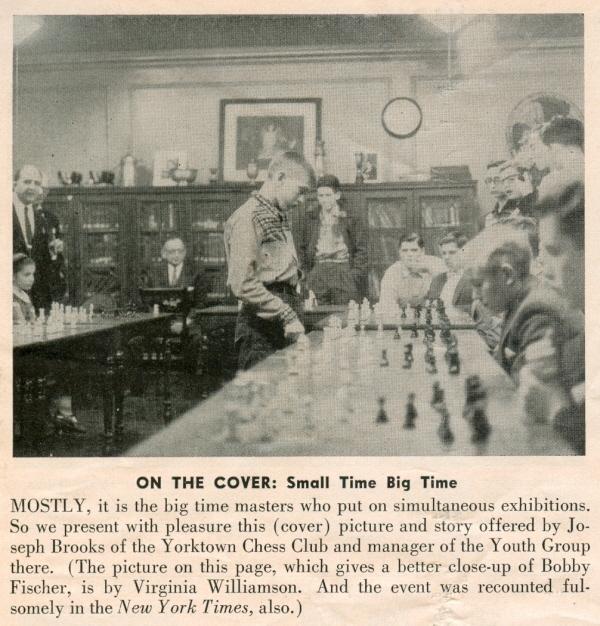
7177. Automatic chess recorder
John Blackstone (Las Vegas, NV, USA) provides an item from page 4 of the Brooklyn Daily Eagle, 26 May 1906:
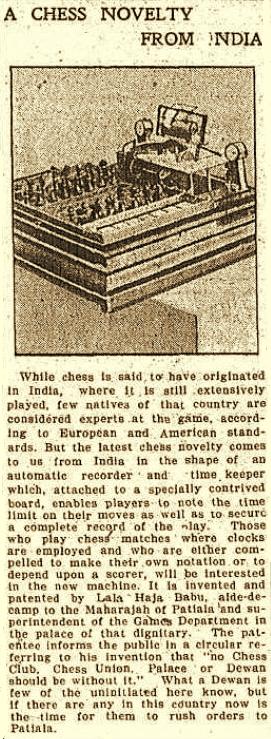
We add an article about Lala Raja Babu from pages 269-270 of the July 1904 BCM:
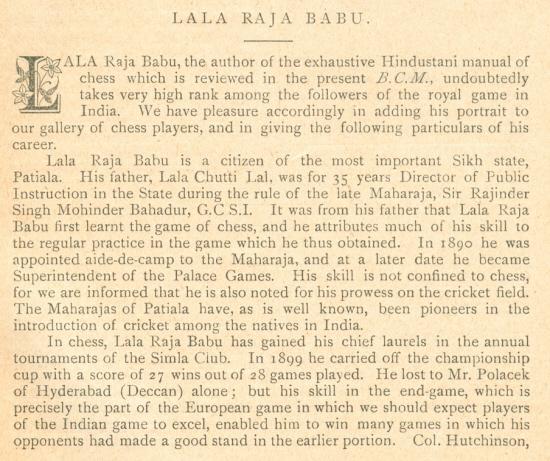
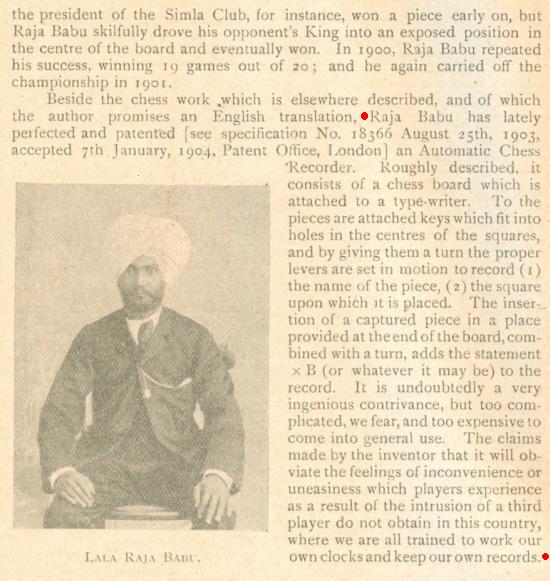
7178. Forcing a winning position
C.N. 888 quoted from page 7 of CHESS, 14 September 1935 a remark by Alekhine:
‘It is practically impossible nowadays to force a winning position with the black pieces against a player of master strength (even if not absolutely first-class standard) who is content to play for a draw.’
7179. Abrahams on Capablanca and Alekhine
‘[Capablanca] had a better conceit of himself than had Alekhine, but was a much nicer and much better-liked man. Alekhine was qualified as a lawyer and had a powerful intellect. He was the only man I ever met who was arrogant without being conceited. What do I mean by arrogant? He treated inferiors as if they were inferiors – but he very rarely made Capablanca’s mistake of taking his own powers for granted.’
Source: page 139 of Not Only Chess by Gerald Abrahams (London, 1974).
7180. Nimzowitsch on Alekhine (C.N. 6684)
A passage from an article by Roberto Grau on San Remo, 1930 was quoted in C.N. 1041:
‘When Alekhine beat Nimzowitsch in such masterly style the first to congratulate him was the defeated man himself. This gesture by the aggressive Nimzowitsch is a token of his admiration for his opponent’s skill, and as he rose from the board he said in a loud voice, “Alekhine plays phenomenally”.’
Source: El Ajedrez Americano, March 1930, pages 66-69.
7181. Alekhine and Bernstein
As reported in C.N. 1041, a letter from Ossip Bernstein dated 5 October 1945 and published in the November 1945 CHESS (pages 28-29) condemned Alekhine:‘My profound attachment to chess restrains me from telling all I think of Alekhine, since the fall of France. In May 1940, I played against him in Paris (a so-called “consultation” game) and won. I could not have guessed that he would behave afterwards as he did. I shall never play against him again and I do not even wish to see him. I refused to meet him at Barcelona, when he visited that city to give chess exhibitions.
I think that the above makes my conception of “collaboration” clear.
The chess world is aware of the tragic end of the grand Polish chessmaster and composer Dawid Przepiórka, who was condemned to death for having entered a café where chess was played; he was forbidden to do that, because he was a Jew. But it is not generally known that Alekhine, though on close terms with the Nazi Governor of Poland, Dr Frank, with whom he was photographed for Nazi periodicals published at the time, refused to intervene to secure Przepiórka’s release. This fact of his non-intervention was told me by Sämisch when he came to Barcelona at the end of 1943. I could also mention articles published by Alekhine after 1940 and the chess exhibitions he gave to entertain the Nazi Forces. I refrain from giving further disgusting details about his behaviour. It could be added that he adopted the Nazi salute “Heil Hitler” with outstretched arm.
I am fully aware of what my statements mean, but I consider it my moral duty and I leave it to you to make conclusions.’
Alekhine’s reply was given on page 76 of the January 1946 issue:
‘Dr Alekhine informs us that the attacks quoted in CHESS of Dr Oskam, who was always his friend, were particularly painful to him.
“As for Dr Bernstein’s ‘information’, I can only state that my friend D. Przepiórka was murdered before the end of 1939 (I heard the narrative of his [sic] from an eye-witness) and it is known that I played in Germany and Poland only from the end of 1941. What connection could I have with this tragical event??
I may add that the game Dr Bernstein gives was played at my home and had an absolutely private character – but of course this has no importance at all.”
Dr Alekhine goes on to say that he has been very sick this year but had to go on playing, or starve. He has had a rest at Tenerife and is feeling much better, but ill-health and worry have sapped his playing ability.’
The attack by Oskam was quoted in Was Alekhine a Nazi? Regarding Przepiórka, it is believed that he was killed in April 1940 (see C.N. 6618).
7182. The death of Przepiórka
The accusation that Alekhine did not intervene on behalf of Dawid Przepiórka was rebutted in a footnote to Alekhine’s obituary on page 87 of the June 1946 Revue suisse d’échecs:
‘Le reproche de ne pas être intervenu en faveur du maître Przepiórka en 1942, lors de son séjour à Varsovie, est infondé. On sait maintenant, par des témoignages récents venant de la capitale polonaise, que le grand maître et compositeur polonais tomba victime de la persécution anti-juive en 1940 déjà, donc deux ans avant la visite d’Alekhine.’
The obituary was written by Erwin Voellmy and Jean-Charles de Watteville, and page 84 had a woodcut of Alekhine by Voellmy:
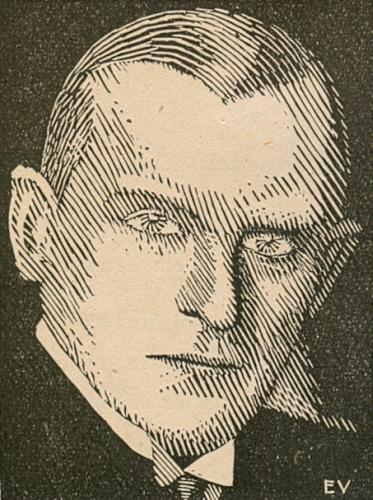
7183. Alekhine and Mrs Alekhine
Page 147 of the April 1946 CHESS reported a claim by E. Voellmy that Alekhine was a paid consultant of the Nazis:
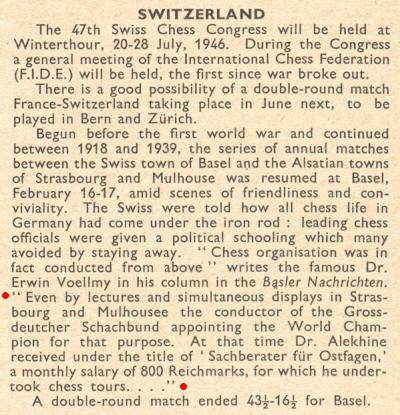
As mentioned in C.N. 1041, Alekhine’s widow denied the Sachberater für Ostfragen charge on page 172 of the May 1946 CHESS:
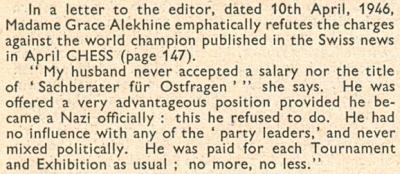
7184. Lawrence Gambit
From page 135 of the December 1904 American Chess Bulletin:
‘A new gambit styled the “Lawrence Gambit”, invented by one of the members [of the Pillsbury National Correspondence Chess Association of Chicago], runs as follows: 1 e4 e5 2 Bc4 Bc5 3 b4 Bxb4 4 c3 Bc5 5 Qb3 Qf6 (best) 6 Nf3.’
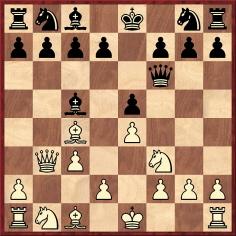
7185. Seletsky
In C.N. 715 (see page 185 of Chess Explorations) a reader asked for biographical information about the Soviet study composer of the 1930s A.S. Seletsky, and the request remains open. Seletsky’s most celebrated composition is probably the one published on page 7 of Chessboard Magic! by Irving Chernev (New York, 1943):
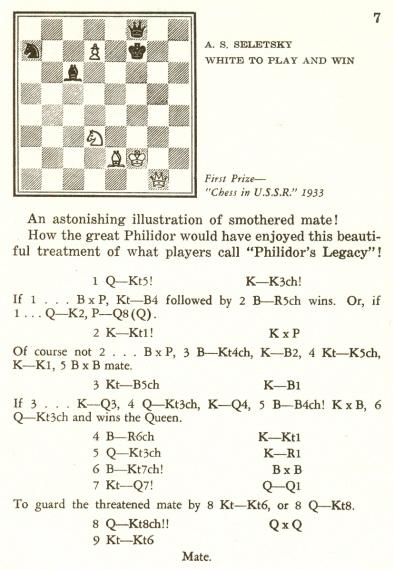
7186. Fischer on Steinitz?
Wanted: information about a quote ascribed to Fischer on page 57 of Bobby Fischer heute by Yves Kraushaar (Schwanden, 1977) and given in C.N. 932:
‘Es gibt nur zwei wahre Schachgenies – das andere war Wilhelm Steinitz, der Weltmeister von 1872 bis 1894.’
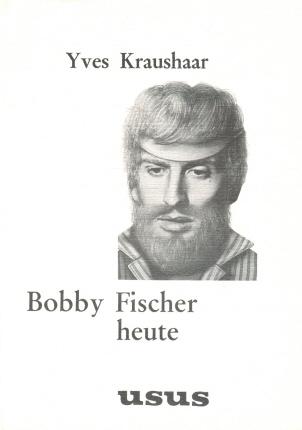
7187. An old position
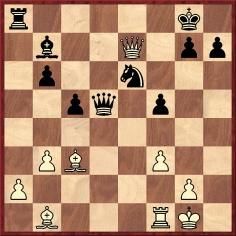
What should White play?
| First column | << previous | Archives [84] | next >> | Current column |
Copyright: Edward Winter. All rights reserved.
